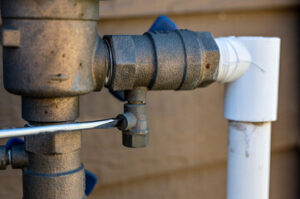In the realm of water systems, maintaining the safety and quality of potable water is paramount. Among the many safeguards in place, backflow prevention devices play a critical role in protecting water supplies from contamination. These devices, designed to prevent the reversal of water flow in plumbing systems, ensure that potentially harmful substances do not mix with clean water. However, their effectiveness relies heavily on proper installation, maintenance, and regular testing.

This is where plumbers step in as indispensable professionals. Their expertise ensures that backflow prevention devices function as intended, safeguarding public health and maintaining regulatory compliance. Contact Plumbers Sarasota for professional help.
Understanding Backflow and Its Risks
Backflow occurs when the flow of water in a system reverses, allowing contaminated water to enter the clean water supply. This can happen due to two primary reasons:
- Backpressure: This occurs when the pressure in a plumbing system exceeds the pressure in the main water supply. For example, if a high-pressure boiler or pump is connected to the system, it can force water to flow backward.
- Backsiphonage: This happens when the pressure in the main water supply drops, creating a vacuum that draws water from a connected plumbing system into the potable supply. This can occur during events like a burst water main or heavy water usage in nearby areas.
The risks associated with backflow are significant. Contaminated water can introduce harmful chemicals, bacteria, or other pollutants into the clean water supply, posing a threat to human health. In addition, backflow incidents can damage plumbing systems and lead to costly repairs.
The Role of Backflow Prevention Devices
Backflow prevention devices are engineered to block the reverse flow of water, ensuring that contaminants cannot enter the potable water system. Common types of these devices include:
- Air Gap: A physical separation between the water supply and potential contaminants, such as the gap between a faucet and a sink.
- Double Check Valve Assembly (DCVA): A device with two check valves that work together to prevent backflow.
- Reduced Pressure Zone Assembly (RPZ): A more advanced device designed for high-risk scenarios, featuring a relief valve to discharge contaminated water.
While these devices are highly effective, they are not infallible. Wear and tear, improper installation, and changes in water pressure can compromise their functionality over time. Regular testing is essential to verify their performance.
Why Plumbers Are Essential for Testing
Testing backflow prevention devices is a specialized task requiring technical knowledge, hands-on experience, and the right tools. Plumbers are uniquely qualified for this role for several reasons:
1. Technical Expertise
Plumbers undergo rigorous training to understand the complexities of plumbing systems. They are familiar with the mechanics of backflow prevention devices and the conditions that can cause failures. This expertise enables them to identify potential issues and ensure that devices operate within acceptable parameters.
2. Certification and Compliance
In many regions, testing backflow prevention devices must be performed by certified professionals. Plumbers often undergo additional training and certification to meet these requirements. Their involvement ensures that testing complies with local regulations and standards, reducing the risk of non-compliance penalties for property owners.
3. Specialized Equipment
Testing backflow prevention devices requires specialized tools, such as test kits that measure pressure differences and check valve performance. Plumbers are equipped with these tools and know how to use them effectively. They can conduct accurate tests and provide detailed reports on the condition of the device.
4. Problem Diagnosis and Repair
If a backflow prevention device fails a test, it must be repaired or replaced promptly. Plumbers are adept at diagnosing issues and implementing solutions. Their ability to handle both testing and repairs streamlines the process, minimizing downtime and ensuring that water systems remain protected.
5. Preventative Maintenance
Regular testing by plumbers not only identifies immediate issues but also helps prevent future problems. Plumbers can recommend maintenance practices to extend the lifespan of backflow prevention devices and improve their performance.
The Testing Process
Testing a backflow prevention device involves several steps, each requiring precision and attention to detail:
- Inspection: The plumber inspects the device for visible signs of damage, wear, or improper installation.
- Setup: Specialized testing equipment is connected to the device. This equipment measures pressure and flow rates to assess the device’s functionality.
- Testing: The plumber conducts a series of tests to evaluate each component of the device, such as check valves, relief valves, and air gaps.
- Analysis: The results are analyzed to determine whether the device meets performance standards.
- Documentation: A detailed report is prepared, outlining the test results and any recommended actions.
If the device fails the test, the plumber will discuss repair or replacement options with the property owner.
The Importance of Regular Testing
Regular testing of backflow prevention devices is not just a regulatory requirement; it is a critical component of public health and safety. Here’s why:
1. Ensuring Water Quality
Testing verifies that the device is functioning properly, preventing contaminants from entering the water supply. This is especially important in environments where hazardous substances are used, such as industrial facilities or healthcare settings.
2. Early Problem Detection
Routine testing can identify issues before they escalate into major problems. For example, a failing check valve may be repaired before it leads to a complete device failure or a backflow incident.
3. Compliance with Regulations
Many jurisdictions require regular testing of backflow prevention devices to ensure compliance with water safety standards. Failing to meet these requirements can result in fines or legal consequences.
4. Protecting Property and Infrastructure
Backflow incidents can damage plumbing systems, appliances, and fixtures. Regular testing reduces the risk of such damage, saving property owners time and money in the long run.
Challenges in Testing Backflow Prevention Devices
Despite the importance of testing, several challenges can complicate the process:
- Access Issues: Some devices are installed in hard-to-reach locations, making testing more difficult.
- Lack of Awareness: Property owners may not be aware of the need for regular testing, leading to neglect.
- Aging Infrastructure: Older plumbing systems may require additional work to accommodate modern testing methods.
- Environmental Conditions: Changes in water pressure, temperature, or quality can affect device performance, adding complexity to the testing process.
Plumbers are equipped to overcome these challenges through their training, experience, and problem-solving skills.
The Broader Impact of Plumbers’ Work
The role of plumbers in testing backflow prevention devices extends beyond individual properties. By ensuring the integrity of water systems, they contribute to the broader goal of public health protection. Their work helps prevent waterborne illnesses, supports environmental sustainability, and fosters trust in the safety of municipal water supplies.
Moreover, plumbers often serve as educators, raising awareness about the importance of backflow prevention. They provide guidance to property owners on maintaining compliance and prioritizing water safety.
Backflow prevention devices are a cornerstone of modern water safety, and their effectiveness hinges on regular testing and maintenance. Plumbers are indispensable in this process, bringing technical expertise, regulatory knowledge, and practical skills to the task.
Through their work, plumbers ensure that backflow prevention devices function as intended, protecting both individual properties and the broader community from the risks of contaminated water. Their contributions underscore the critical role of plumbing professionals in safeguarding public health and maintaining the integrity of water systems.
In a world where clean water is essential to life, the expertise of plumbers in testing backflow prevention devices cannot be overstated. Their commitment to excellence and safety ensures that water remains a reliable and uncontaminated resource for all.
